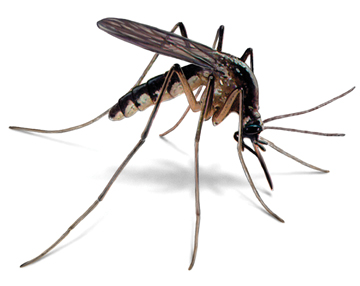
INTRODUCTION. Mosquitoes are well known by most people because of their pesky biting habit. Of greater concern, they are very important as vectors of numerous human diseases such as West Nile virus, malaria, yellow fever, filariasis, dengue, and encephali¬tis. Mosquitoes are distributed throughout the world, including the United States.
RECOGNITION. Adults about 1/8-3/8" (3-9 mm) long; body and legs usually covered with scales. Color mostly gray to dark, some marked with white, silver, green, or iridescent blue scales. Head with proboscis/beak long; ocelli absent. Antennae 15- segmented, plumose (feathery) in male, hairy in female. Wings 2 in number, long, narrow, with scales along veins and wing margin; outer part of wing with an unforked vein between 2 forked veins.
Mosquitoes are commonly separated into 3 groups based on where and how their eggs are laid. After a blood meal, the female will lay her eggs: (1) singly on water, eggs with floats, usually hatch within a few days, e.g. Anopheles; (2) in rafts on water with up to 100+ eggs per raft, usually hatch within a few days, e.g. Culex; and (3) singly in semi-dry places such as moist soil near water, do not hatch until water has risen and inundated them, can lie dormant for 3-5 years, e.g. Aedes and Ochierotatus. With water present, eggs hatch in a few days into larvae which are commonly called wig- glers because of their jerky movements. All larvae live in water and go through 4 instars and 4 molts. Larvae of most species (e.g. Aedes, Culex, Ochierotatus, etc.) take in air through a breathing tube (siphon) located on the 8th abdominal segment which penetrates the water surface while they float at an angle just below the surface. Other species (e.g. , i Anopheles) have a spiracular plate on the 8th abdominal segment which penetrates the surface while they float parallel to and just below the surface, their buoyancy enhanced by clusters of float hairs (palmate hairs) on some abdominal segments. With their 4th molt, the larvae become pupae which are commonly called tumblers. The pupae live in water and are very active. The pupae of most species breathe through a pair of respiratory trumpets located on the dorsal thoracic surface which penetrate the water surface while they float just below the surface. At the end of the pupal stage, while at the water’s surface, the pupal skin splits open and the adult works its way out and onto the surface of the water, briefly dries and flies away. Developmental time (egg to adult) is usually about 10-14 days; eggs hatch in 1-3 days to 5 years, larval stage lasts 7 days to weeks, and pupal stage takes 2-4 days to a few weeks. Adult females may live up to 1-2 months (males about 6-7 days) in the summer or for 6+ months if they overwinter. Mosquitoes serve as vectors of many important diseases affecting humans including West Nile virus, malaria, yellow fever, dengue fever, filariasis, and encephalitis. Refer to the chart entitled “Biological Data on Medically Important Mosquitoes in the U.S.” (page v 3.18.5) for a summary of such diseases. Also of interest is the dog heartworm (Dirofilaria immitis (Leidy)) which is a common mosquito-transmitted filarial parasite of dogs and is a serious problem from Minnesota to Illinois to Texas and eastward.
HABITS. Mosquitoes have adapted to almost every kind of aquatic situation such as permanent ponds and marshes, temporary flood waters or woodland pools, drainage ditches, and water contained in tree holes, leaves of plants, or artificial containers. The exceptions are flowing streams and the open waters of large streams, rivers, lakes, seas, and oceans. The number of generations per year ranges from 1 where the eggs require cold before hatching (e.g. some Anopheles), to many in warm climates where most breed continuously. The larvae of most species feed on small aquatic organisms and organic debris which they strain out of the water with a series of oral brushes. Although quite active, the pupae do not feed. The adult males feed on nectar. Although the adult female also feeds on nectar, females of most species require a blood meal before they can lay fertile eggs. Females require 2+ days to digest a blood meal, lay a batch of eggs, and then seek another blood meal. The flight range of mosquitoes varies with the species, temperature, wind direction, time of year, and distance to blood meal sources. For various species of Aedes and Ochierotatus (for 7 species formerly in Aedes, see table page 3.18.5), the range for recap¬tured marked females was from 18 mi (29 km) along coastal Georgia to 110 mi (177 km) at sea off the coast of North Carolina. These records probably represent females that got caught up in wind currents because their normal flight ranges are much shorter, about 5-10 mi (8-16/km). The time of day in which biting occurs varies with the species. Most medically important species bite at dusk and dawn (crepuscular) and also during the night (nocturnal), e.g. the vexans mosquito (Aedes vexans), the southern house mosquito (Culex quinquefasciatus), and the encephalitis mosquito (Culex tarsalis), whereas others bite only at dusk and dawn such as the eastern saltmarsh mosquito (Ochierotatus sollicitans). Several species of medical importance bite only during the daytime (diurnal) such as the Asian tiger mosquito (Aedes albopictus), and one species, the yellowfever mosquito (Aedes aegypti), bites during the day but also at dawn and dusk. Some species which normally do not bite during daytime will do so if disturbed, for instance by someone walking through high grass on which they are harboring.
CONTROL. Mosquito control begins with an accurate and thorough assessment of the problem through surveillance and then using the control measures best suited to the situation. Control measures may include one or a combination of techniques to: (1) eliminate mosquito-producing areas via habitat modification; (2) control mosquito larvae via pesticides, insect growth regulators (IGR’s), biologicals, monomolecular films, and/or predatory fish; and (3) control of adults via ULV pesticide applications. For success, v control efforts must not be dictated by political jurisdictions but instead by mosquito biology and distribution.
On the household level, relief can be achieved by preventing entry into structures via proper screening and sealing, the application of appropriately labeled residuals to resting surfaces, and ULV treatment to infested rooms. On the personal level, the use of repellents is quite effective. In areas of heavy infestation, full-head nets (similar to bee veils) are useful when outdoors and mosquito nets are useful when/where sleeping.
Please call us today for a free quote for the control of mosquitoes.


